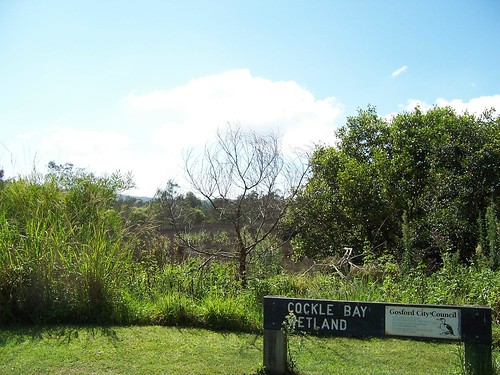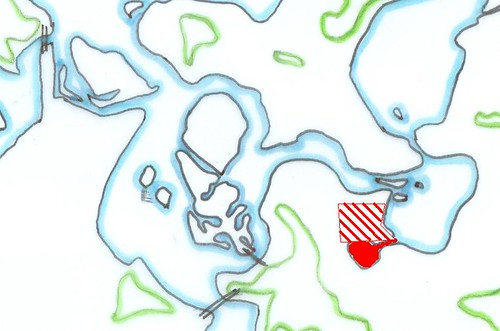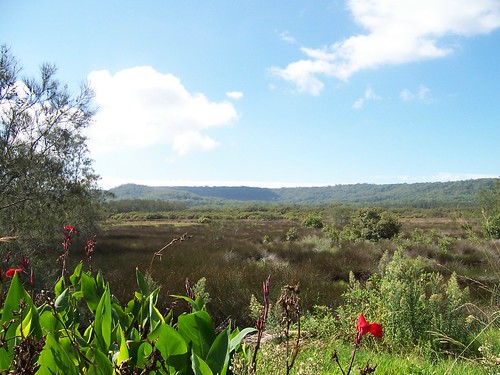
Cockle Bay Wetland Kendall Road Empire Bay.
Looks like just a bit of scrubby ground to us humans and non-botanists but it's the garden of eden to local birds and beasts:
"Cockle Bay and its surrounds is the largest example of an estuarine wetland in
Brisbane Water. It is an extremely important area for avian fauna, such as
wading birds and cormorants that utilise the wetland for feeding, breeding and
shelter sites. There are also a number of reptiles and mammals inhabiting the
area." (Gosford City Council records 2003)

Cockle Bay & its Wetland in red. Woy Woy on the left bottom.

We're looking south-east here, across a not-visible Bensville here and over to the Bouddi National Park (pronounced bood-eye, oo as in hood). The other side of the Bouddi is the Tasman Sea.

Pelican Island & Rileys Island are Dry Sclerophyll Forest. Cockle Bay is Swamp Sclerophyll Forest.
Swamp Sclerophyll Forest is "typically open forest, although partial clearing may have reduced the canopy to scattered trees. In some areas the tree stratum is low and dense, so that the community takes on the structure of scrub. The community also includes some areas of fernland and tall reedland or sedgeland, where trees are very sparse or absent. Typically these forests, scrubs, fernlands, reedlands and sedgelands form mosaics with other floodplain forest communities and treeless wetlands, and often they fringe treeless floodplain lagoons or wetlands with semi-permanent standing water (e.g. Pressey 1989a)."
Now you've chewed yer way through that lot, think about what Hurricane Katrina did to New Orleans. A lot of that flooding was due to the wetlands getting developed. Wetlands slow floods and tidal surges right down and take the bite out of them. The same goes here.
Swamp Sclerophyll Forest on the Central Coastal Floodplains ... is likely to be made up of these species:
Acacia irrorata - a eastern coast wattle, "Erect shrub or tree to 12 m high. Bark smooth, later rough, green, dark grey, dark brown or black. ... Young foliage-tips golden, greenish yellow or orange."
Acacia longifolia - a wattle with a long thin seed-pod.
Acmena smithii - lilly pilly tree, gets to 15 m, upright oval-shaped tree, "used as a single tree or as a hedge since the early 1900s", "fragrant white flowers in late spring, and these flowers are followed fruits—in most Lilly Pillies these are a deep purple".
Adiantum aethiopicum - Adiantum aethiopicum - Common Maidenhair fern. This stuff grows back thicker after a dose from the flame-thrower.
Allocasuarina littoralis - Black Sheoak, "easily recognised because of its very short leaves, typically only 5-8cm in length ... These branchlets are very fine, bright green, and contrast strongly with the black bark. The tree’s growth is upright, and A. littoralis will grow no wider than 4m", dark red spring flowers.
Banksia oblongifolia - Fern-leaved banksia, Banksia oblongifolia was previously known as Banksia aspleniifolia in New South Wales. Good photo there of the seed cone.
Banksia spinulosa - Hairpin Banksia, straight golden cones.
Baumea articulata - Jointed Twig-rush, Stout sedge 1 -2 m tall, large drooping flowerhead.
Baumea juncea - a thin reed plant, I've seen this everywhere on the Central Coast and in Sydney as well, along the Parramatta River I think.
Blechnum camfieldii - another reedy plant by the look of it.
Blechnum indicum - Swampwater Fern, a bush tucker plant and pretty popular as a garden plant. Bit like a hedonistic fishbone fern.
Breynia oblongifolia small shrub with little red berries.
Callistemon salignus - Willow Bottlebrush, small fat tree that went out of fashion in the eighties.
Calochlaena dubia - Common Ground Fern, Rainbow Fern, low job about knee height. I see this all over the place round Brisbane Water, on the ridges as well as in the wetlands. It's so common and visible I thought it was one of the exotic species that turned into a weed.
Carex appressa - ornamental tussocky grass, a low reedy/spiny job found round swimming pools.
Casuarina glauca - Swamp Oak, prostate job (laying down), "Casuarinas are often called “native pines” because their foliage bears a similarity to pine needles. ... [however] they are in fact true flowering plants. The Casuarinaceae family is native to Australia, southeast Asia and islands of the Pacific."
Centella asiatica - Pennywort. Creeping herb, heart or kidney shaped leaves, pink or white flowers. Think I've seen this one.
Dianella caerulea - another one of these reedy tussocky jobs, low thing with a stalk of blue or purple flowers, see in shopping centres all over as an edging in the carparks.
Dodonaea triquetra - Large Leaf Hop Bush. Erect shrub to 3 metres. Looks more like a small scrawny tree. Pretty common on bushwalks round the Peninsula.
Elaeocarpus reticulatus - Tree-ish shrub or shrub-ish tree, small white or pink fringed bell flowers and blue olive-shaped berries. The link shows it as a bonsai. Cool.
Entolasia marginata - Australian panic-grass. It's been introduced into Hawaii. I know this stuff. We used to pick bunches of it on the way home from primary school (middle school) and whack each other with it about the head. It didn't pack much of a punch but the dust flying off in all directions gave the allergic kids hell.
Entolasia stricta tall thin straggly weedy grass. Australians will know it next time they see it, the stuff's everywhere.
Eucalyptus botryoides - Bangalay, a coastal gum tree, one of the ones with small nuts out of which the flowers burst like tiny fireworks..
Eucalyptus longifolia - Woolybutt gum, one of yer classic gum trees, 15 - 25 m, white/ white and grey bark, sheds it in patches or strips, pale yellow firework flowers. This is one the lorikeets like.
Eucalyptus resinifera subsp. hemilampra - Red mahogany, one of the stringbarks, gets to 45 m high, plae yellow firework flowers again.
Eucalyptus robusta - Swamp Mahogany, another tall gum. I see this one a lot in planted parks. It makes good shade.
Ficus coronata - Sandpaper Fig, tall shrub or small tree, rough sandpapery leaves. Small dark hairy berries. Bush tucker plant, just peel the hairy skin off.
Gahnia clarkei - Tall Saw-sedge, a stiff reedy grass with "scabrous" leaves. A butterfly hotel, the butterfly being a yellow and black job. I've both plant and butterfly, though not in the last few weeks.
Gahnia sieberiana - another Saw-sedge, this one with red fruit apparently. It's a knee high job, dense and round, probably the inspiration for those hideous seventies lamps with the slowly changing coloured light in the base. Don't look at one of those when yer drunk, it'll do yer head in. Do yerself a favour and leave it in the fucking garage sale.
Glochidion ferdinandi - Cheese tree, a large shrub. I've seen one of these. They're weird. The flowers are like tiny round cheeses that're going off.
Glycine clandestina - Twining Glycine, a sparse wandering viny thing, likes to drape itself over large bushes. I've seen this one, mostly on the ridges though.
Gonocarpus tetragynus - Common Raspwort, perennial herb. Low grassy thing, likes to grow in dips in rock platforms on the ridges as well. Has tiny reddish knobbly flowers at the tip of the leaves.
Hydrocotyle peduncularis - no common name by the look of it, a straggly weedy thing, the sort you'd just yank out if you found it in the garden. Found in Antartica and the sub-antartic.
Hypolepis muelleri - Harsh Ground Fern. Seen this all over the place as well. "[C]overed with stiff dark brown hairs" and "fronds erect" says FloraOnline. Sounds like a bear I used to know.
Imperata cylindrica var. major - Satin-tail, Spear-grass, a knee-high reddy grass with short white plume flowers. "It is used for erosion control, mulch in coffee plantations, fodder, thatching, paper-making, packaging, fuel and ornamental purposes but is also a common weed in hot climatic conditions." says Ecoport.
Isachne globosa - another grass but found in Asia, Australia and the Pacific islands. Not terribly useful from what I can see.
Leptospermum polygalifolium subsp. polygalifolium Tantoon, a short-arsed (short) tea tree with tiny greenish or white flowers. Ah, tea tree, how I love thee, let me count the ways. "Heath or sclerophyll forest on deep sand or in skeletal soil, usually on sandstone, often in moist depressions or along rocky watercourses," says PlantNet. And that's a pretty good description of the Brisbane Water/Greater Gosford area right there.
Livistona australis - Fan Palm, Cabbage Palm, tall tree with a round crown of fan-shaped leaves. Wind and salt tolerant. I see one of these among the scrub every now and then and assume it's an escaped garden plant. Shows you how much I'm learning.
Lomandra longifolia Spiny-headed Mat Rush, a low reed along the edge of the water. Click that link to see the fishing baskets the Aboriginal people made (and probably still make) out of it.
Lophostemon suaveolens - Swamp Mahogany, Swamp Turpentine, Swamp Box. Small droopy tree by the look of it. Broad-ish leaves, rough brown bark and tiny waxy white floers like the tea trees.
Melaeuca ericifolia - Swamp Paperbark tree, bark comes off in patches with stringy bits between the layers. Creamy white bottle-brush type flowers.
Melaleuca linariifolia - Narrow-leaf Paperbark, 8 m tall tree. Used a lot as a street tree and garden tree.
Melaleuca quinquenervia - Broad-leaved Paperbark. They were imported into the Florida Everglades 50 years back to stabilise the banks. Bad idea. They're too good at it and have taken the place over.
Melaleuca sieberi - small Paperbark tree. Grows "in wet heath in coastal districts, north from Gosford," says PlantNet. The nuts grow along the twigs. I love that.
Melaleuca styphelioides - Prickly Paperbark, a 10 m tree, no low branches and a wide squat crown. "[A]nother plant that is currently out of fashion. Many of these Melaleucas were poorly sited when planted and the original planting stock was of extremely poor quality. Now many of these trees need to be removed, and streetscape managers are looking for alternatives," says Metro Trees.com.au
Morinda jasminoides - Native Jasmine, a vine with dark glossy leaves and tight bunches of tiny white and yellow flowers and orange fruit. I've never seen this. I wonder if it would like to live on my wall.
Omalanthus populifolius - Native Bleeding Heart, a tall shrub with red and green heart-shaped leaves. Think I've seen that in a few gardens.
Oplismenus aemulus - no common name, looks like a weed. Very unexciting.
Parsonsia straminea - Common Silkpod, a vine that grows on trees in places like Fletcher's Glen.
Phragmites australis - Common Reed. Upright woody stems with leaves off them, bit like bamboo. Bush tucker plant, also good for basket and raft making.
Polyscias sambucifolia - Elderberry Panax. A soft cascading shrub with tiny peeled-back white and yellow flowers and blue-grey fruit in summer.
Pratia purpurascens Whiteroot. A tiny native herb, fiercely defended.
Pteridium esculentum - Austral Bracken. Pretty sure I've seen this locally as well. Though it might've been one of the ferns.
Stephania japonica var. discolor - Snake Vine. A vine, obviously, with vaguely heart-shaped leaves that go red. Heard of it but never seen it.
Themeda australis - Kangaroo Grass. Scruffy-looking grass with reddish tufts on the end of the leaves.
Villarsia exaltata - Yellow March Flower. Erect, tufted, perennial aquatic herb with bright yellow flowers with five separated leaves.
Viola banksii & Viola hederacea - Native Violet. Very low plant with small purple and white flowers. "Vigorous perennial herb," says PlantNet, "spreading with stolons." Stolons turn out to be runners, like strawberry plants get if you grow them in the ground.
(List from NSW National Parks, smartarse remarks from Spike.)
Okay. I'm pooped after that lot. Feel free to play Spot The Species while I recover.
4 comments:
hi spike, thanks for all those names and the links; so useful. Today, by coincidence, I bought an elaeocarpus reticulatus for our mainly australian native garden Its a blueberry ash.
Yer welcome.
Excellent. Yours'll be the only not-dead garden in the street :)
Ok, what is the plant in the bottom lefthand corner? I've seen it often here, but it doesn't seem well-suited to our area -- the leaves always get brown in the winter. Lovely wetland.
Jen - Dunno. There were a few clumps of it planted along the verge of Kendall Road and I left it in for a bit of extra colour.
I've seen it heaps of times in gardens from the 30s and 40s and I think it's from South Africa but related to some Australian natives through the Gondwana connection.
It might be a rhodedendron or I might be talking out of my arse.
Post a Comment